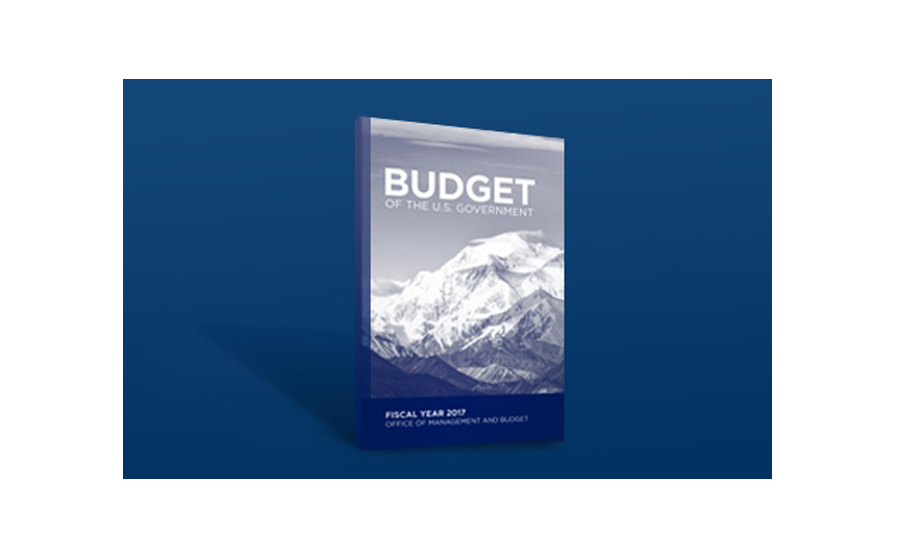President Obama’s final budget proposal is filled with minus signs for many major federal construction programs in fiscal year 2017, including General Services Administration new buildings, Army Corps of Engineers civil works and Environmental Protection Agency water infrastructure.
But the $4.1-trillion budget request, sent to Congress on Feb. 9, includes some offsetting hikes, too, including highway and transit programs. They would be in line for increases that track the 2017 numbers in the recently enacted FAST Act, which authorizes $305 billion over five years for highways, transit and passenger rail.
Overall, the Associated General Contractors of America calculates, the Obama FY17 budget includes a total of $141 billion for construction programs, up about 14% from the $123.9 billion in enacted fiscal 2016 construction appropriations.
But all of that year-to-year increase would be accounted for by programs under an Obama-proposed 21st Century Clean Transportation Plan. The plan would total $17.9 billion in 2017, including about $8 billion for the Federal Transit Administration, according to U.S. Dept. of Transportation figures.
The administration would fund the clean transportation plan through a new $10 per barrel tax on oil. But leading congressional Republicans have bluntly rejected the idea. For example, House Speaker Paul Ryan (R-Wisc.) called the proposal “little more than an election-year distraction” that was “dead on arrival.”
If the clean transportation plan isn’t adopted, the budget’s 2017 construction total would be about flat with 2016. Moreover, notes Sean O’Neill, AGC congressional relations director for infrastructure advancement, “The major accounts that we do follow did see a decrease almost across the board.”
The release of the administration budget is just the beginning of months of scrutiny and debate by congressional appropriators, who will set final spending levels for each line item later this year. Marco Giamberardino, National Electrical Contractors Association executive director of government affairs, says, “I would hope that when Congress receives this budget that they recognize the progress they made with the investments made with the FY16 omnibus.”.”
Industry lobbyists will push for increases in construction accounts, and seek to reverse Obama’s proposed reductions from 2016 levels. “If you look at the needs out there, we’re a long way from addressing the needs we have,” AGC’s O’Neill says.
Construction groups face a tough fight as they seek to convince appropriations committees to increase infrastructure accounts. “It always is, “ says O’Neill.
Appropriators do have room for some 2017 increases. Last year’s two-year budget agreement called for an overall 2017 discretionary spending cap of $1.07 trillion, $30 billion more than the 2016 limit, with the increase divided between defense and nondefense programs.
Among transportation programs, the federal highway obligation ceiling would edge up 2%, to $43.3 billion, the level that the FAST Act authorizes.
Excluding the Clean Transportation dollars, transit funding would get a 2% boost, to about $12 billion, its FAST Act allotment for 2017. But the budget plan trims the Federal Aviation Administration’s Airport Improvement Program construction grants 13%, to $2.9 billion.
The Obama proposal also slices the Corps’ civil works funding 22%, to $4.6 billion. Within that total, the proposal slashes the Corps construction account 41%, to $1.1 billion, and cuts its operation and maintenance spending 14% to $2.7 billion.
Kurt Nagle, American Association of Port Authorities president and CEO, said in a statement that his group was pleased to see the surface transportation increases but “deeply troubled” by the reductions in Corps navigation spending.
John Doyle, special counsel with law and lobbying firm Jones Walker LLC, calls the civil works request “a disaster.” In the omnibus spending package less than two months ago, he notes, “Congress sent a completely contrary signal about its strong support for the program.”
Doyle, formerly a senior Army civil works official, adds, “I have every expectation that Congress will come much closer to the numbers that they provided in the omnibus….”
Among environmental programs, the plan pares EPA water infrastructure 7% to $3.3 billion. That includes a 30% cut in EPA aid to clean water state revolving funds (SRFs), which help finance wastewater treatment projects. That account would be left with $980 million for 2017.
But in the wake of the Flint, Mich., water supply crisis, the budget seeks to increase aid for EPA drinking water SRFs 18%, to slightly more than $1 billion.
Patricia Sinicropi, National Association of Clean Water Agencies director of legislative affairs, says, “It doesn’t pay to take money from one program to give to another. Both programs need to be substantially funded.”
At the Dept. of Energy, the defense environmental restoration program, which involves remediation at former nuclear weapons facilities, would get a modest 2% hike, to $5.4 billion.
Federal buildings programs won big increases in the fiscal 2016 omnibus enacted in December, but the Obama budget chips away at those gains. For example, it proposes to cut GSA new construction 17%, to $1.3 billion, and the Dept. of Veterans Affairs major construction account 58%, to $528 million.
Dept. of Defense construction—which includes facilities and other types of infrastructure—also fared well in the 2016 omnibus but Obama’s 2017 request seeks an 11% reduction, to $7.4 billion.
Federal Spending
Obama FY 2017 Budget Cuts Many, But Not All, Construction Programs

Credit: photo courtesy of the White House



Post a comment to this article
Report Abusive Comment